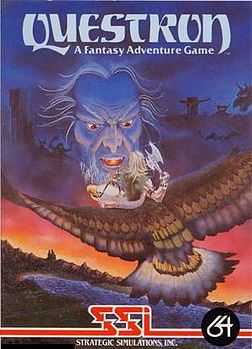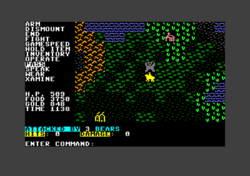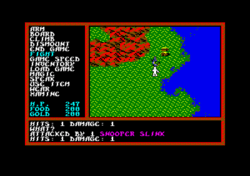Questron
| Questron | |
|---|---|
 Cover art | |
| Developer(s) | Strategic Simulations, Inc. |
| Publisher(s) | Strategic Simulations, Inc. |
| Platform(s) | Commodore 64, Apple II, Atari 8-bit |
| Release date(s) | 1984 |
| Genre(s) | Role-playing video game |
| Mode(s) | Single player |
Questron is a fantasy role-playing video game series produced by Strategic Simulations, Inc.[1]

In Questron the player takes on the role of a young serf who tries to make a name for himself by traveling the realm in order to gain the power and experience necessary to defeat the wicked "Mantor", ruler of the "Land of Evil".
The view is mostly in top-down style for the world maps and town encounters, but switches to a 3D first-person style in the dungeons of the Land of Evil. Some features were novel for a game of its type at the time of its release. First there are two "games within a game" that allow the character to permanently increase dexterity or intelligence attributes if completed successfully. Also, various casinos about the towns allow the player to gamble for gold pieces in games of blackjack, roulette and double or nothing.
The moral tone of the game is unusual. You can rob and kill merchants, and to progress in the game to the Land of Evil you must storm a castle and kill the guards. The king of that castle will knight you for your courage.
Another aspect of the game is that various monsters and foes are immune or more vulnerable to different weapons. The player would occasionally have to switch weapons depending on which enemy they faced in order to defeat them. Magic spells can also be cast, but only in the dungeon levels.
The original game was written by Charles Dougherty and Gerald Wieczorek and published in 1984 for the Atari 800, Commodore 64 and Apple II computer systems. After an out-of-court settlement, the structure and style of the game were both officially licensed from Richard Garriott, author of Akalabeth and Ultima.[2][3][4] This game was the first foray by SSI into the fantasy RPG genre and its release was followed by the more expansive Phantasie series.
| Questron II | |
|---|---|
| Developer(s) | Strategic Simulations, Inc. |
| Publisher(s) | Strategic Simulations, Inc. |
| Platform(s) | Commodore 64, Apple II, Apple IIgs, Atari ST, Amiga |
| Release date(s) | 1988 |
| Genre(s) | Role-playing video game |
| Mode(s) | Single player |
Questron II

In 1988 a sequel was made for the Apple II, Apple IIGS, Atari ST, Commodore 64, IBM PC and Amiga computers. It featured similar gameplay to the original with improved graphics and features. This game's programming, artwork and rules are credited to Westwood Associates[5] while the storyline and original design are credited to Quest Software. This game was also produced by Strategic Simulations, Inc.[6]
The premise of this game is that the player's character has been sent back in time to defeat six "Mad Sorcerers" before they can create the "Book of Magic" featured in the original game.
Related games
John and Charles Dougherty also made two other games which were credited to Quest Software. The brothers produced Legacy of the Ancients in 1987 for the Apple II & Commodore 64 (and later the PC), followed by its sequel Legend of Blacksilver in 1988. Both games used an updated version of the engine used by Questron.
Reception
Ahoy! praised the Commodore 64 version of Questron, describing it as "one of those game that you start playing and suddenly realize it's three hours past bedtime. SSI should label the box 'potentially hazardous to your sleep'".[3] Computer Gaming World stated "if you are in need of a new and challenging role-playing game similar in play to the Ultima scenarios, then look no further". It praised the 3-D dungeons and "an ending fit for a king", and concluded "the differences from the Ultima type game do make Questron refreshing. I await the sequels".[7] Another reviewer also liked the game and praised the ending.[8]
Computer Gaming World described Questron II as very similar, albeit not equal, to the original.[9][8] Questron II was reviewed in 1988 in Dragon #138 by Hartley, Patricia, and Kirk Lesser in "The Role of Computers" column. The reviewers gave the game 4 out of 5 stars.[10]
Phantasie I, Phantasie III, and Questron II were later re-released together, and reviewed in 1994 in Dragon #203 by Sandy Petersen in the "Eye of the Monitor" column. Petersen gave the compilation 2 out of 5 stars.[11]
References
- ↑ Barton, Matt (2007-02-23). "Part 2: The Golden Age (1985-1993)". The History of Computer Role-Playing Games. Gamasutra. Retrieved 2009-03-26.
- ↑ From Questron in-game menu screen, Apple II and Commodore 64 versions.
- ↑ 3.0 3.1 Peterson, Cheryl (October 1985). "Questron". Ahoy!. pp. 64–65. Retrieved 16 October 2013.
- ↑ Maher, Jimmy (2014-06-25). "Of Wizards and Bards". The Digital Antiquarian. Retrieved 11 July 2014.
- ↑ From Questron II instruction booklet, IBM PC version.
- ↑ From Questron II in-game menu screen, Commodore 64 version.
- ↑ McPherson, James A. (June 1984). "Questron". Computer Gaming World (review). p. 18.
- ↑ 8.0 8.1 Scorpia (October 1991). "C*R*P*G*S / Computer Role-Playing Game Survey". Computer Gaming World. p. 16. Retrieved 18 November 2013.
- ↑ Scorpia (August 1988). "Questron II". Computer Gaming World. pp. 8–9, 50.
- ↑ Lesser, Hartley; Lesser, Patricia; Lesser, Kirk (October 1988). "The Role of Computers". Dragon (138): 70–75.
- ↑ Petersen, Sandy (March 1994). "Eye of the Monitor". Dragon (203): 59–62, 69.
External links
- Questron at MobyGames
- Questron II at MobyGames
- Questron II on the Amiga at the Hall of Light (HOL)
- Images of Commodore 64 version of Questron box, manual and screen shots at C64Sets.com